By Robert Bruce
SAR’s readers have the rare privilege of joining Robert Bruce as he goes behind the scenes of the United States Navy Museum and into the heavily secured arms storage vault maintained by the Naval Historical Center, the United States Navy’s official keeper of information, photographs, and artifacts that represent more than 200 years of proud service.
Mark Wertheimer, head of Materiel Section, Curator Branch, conducted the tour of this little-known national treasure and sat for an extensive interview on all aspects of the collection.
SAR: What is the purpose of the NHC’s weapons collection and some examples of how this purpose is served?
Mark: It serves as a material reminder of the operational, technical and social aspects that firearms have been a part of in naval history. We make them available for research, study and display.
An example of research is like what you’re doing with the SEAL weapons — photographing them for publication. Also to further future development of small arms and weapons in the US Navy and other Armed Forces. Our collection is one of many available for this RTD&E (research, development, test and engineering) database. We lent out the special 50-round magazine that Carroll Childers did as a quick-fix for SEALs in Vietnam. This was requested by a Navy organization along with its technical documentation.
(Editor’s NOTE: See Robert Bruce’s feature, “The Childers S.O.W.” in SAR, May, 2002)
Mark: A typical study might be by Naval Historical Center (NHC) personnel for one of our many publications. A staff member will view particular weapons in our holdings. Also, to learn about the past of the Navy in a general sense.
Most study is done from an operational standpoint – particular weapons in particular operations. How that’s been applied, lessons learned, that sort of thing. The weapon itself serves almost like in a court case – a piece of evidence. Someone wants to see it so you break it out of the vault for him.
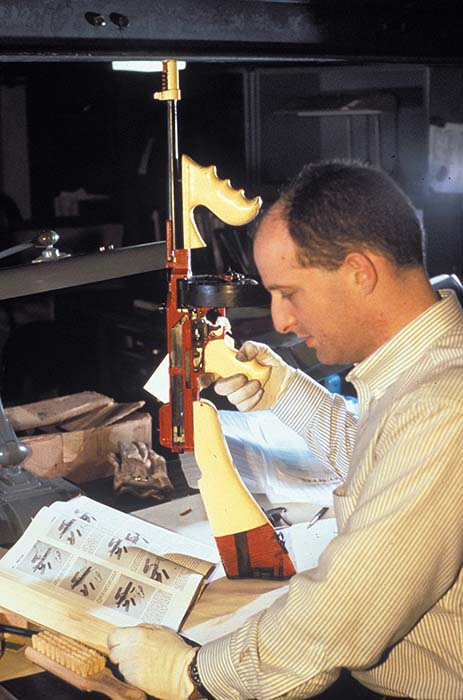
Curator Mark Wertheimer at work in the vault, comparing details of an unusual cutaway Thompson M1928A1 submachine gun against entries in an early edition of Small Arms of the World. The collection includes not only guns and related artifacts, but also an extensive technical library. This gun was once used as a training aid by the FBI academy and was accepted into NHC’s collection due to its value as a mechanical reference. Credit: Robert Bruce
SAR: And display?
Mark: The chronological history of the United States Navy is presented in our flagship museum here at the Washington Navy Yard. Approximately 100 specially selected firearms are on display there, representing the broad spectrum of Navy history. This is the best place for the casual visitor to get a good overview of Navy small arms.
There are nine other official Navy and other government museums that have our firearms on display as well as some non-government civilian naval-related museums like the 42 historic ships around the United States. There are about fifteen locations in all including the battleship North Carolina, UDT-SEAL Museum, and others.
SAR: How about some examples of weapons that represent the full span of the NHC holdings?
Mark: Well, our earliest American long arm is an 1803 production of the Model 1795 musket in .69 caliber. We also have a French Naval Pistol from the 1770s that saw service in the American Revolution. On the modern end we’ve just gotten in some things from Operation Enduring Freedom in Afghanistan.
The biggest artifact is definitely the Kodak Mark 1 Mod 0 60mm mortar from 1945.
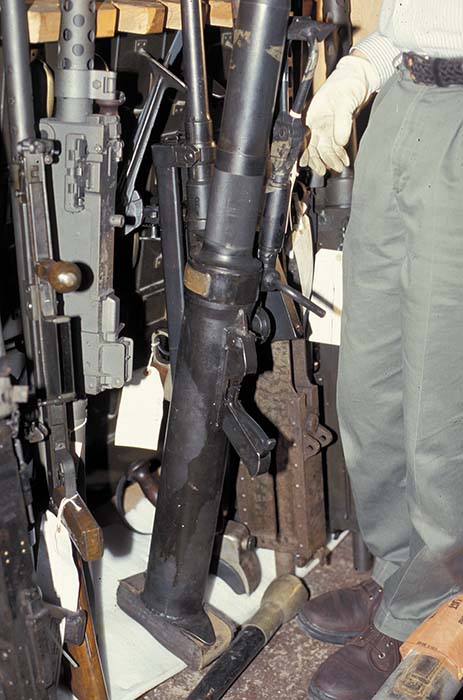
Reaching into a rack of various machine guns, Wertheimer selects a Mark 1 Mod 0, an example of the remarkable shoulder-fired T20 series of 60mm mortars, developed for the Marine Corps in World War II. Starting with the firing mechanism of the novel 50mm Japanese Type 89 Mortar, known colorfully though inaccurately as the “knee mortar,” a recoil and counter-recoil system allowed firing standard US 60mm mortar shells (without added propelling increments) from the shoulder if necessary. Testing showed sufficient promise and some 100 were made for combat evaluation. Sharp-eyed readers will note in the rack (left to right): an Italian Breda, German MG08/15 and 08, Chauchat Model 1918, and Browning M1919A6. Credit: Robert Bruce
SAR: A mortar made by the Kodak camera company?
Mark: Yes, and it is designed to be carried and fired by one man – from the shoulder….
Our smallest weapons include some .22 caliber handguns, but the smallest artifact is probably in our ammunition collection. This is a tiny arrow-shaped steel flechette from the special rounds developed in the Vietnam War for SEAL shotguns.
SAR: Where did most of your post-World-War-II weapons come from?
Mark: The Navy Bureau of Ordnance, now called Sea Systems Command. They have their own research level T&E (test and evaluation) holding at Crane, Indiana. I should note that “minor caliber weapons in-service engineering “ is done at NSWC, Louisville, Kentucky.
SAR: How about weapons of foreign navies? I saw quite a few German, Japanese and even Russian weapons in the vault.
Mark: We keep some that were used by our adversaries and our allies. Telling the Navy story includes what we were up against and how our weapons match up. Are there any lessons that we can learn from them – certainly at the technical intelligence level – about what we are up against?
Also, it can be the things our friends were successfully using. For example, we have a silenced STEN submachine gun in the collection.
Sometimes the foreign weapons that we use or have used are not so well known. The earliest Russian arm in the collection was actually part of the US Navy’s developmental program for the Plymouth Rifle – an 1839 musket with nice Cyrillic markings.
SAR: How about any of the newer acquisitions?
Mark: Well, we have a 9mm Sig-Sauer P228 pistol that the Navy calls the M11. This is from a batch originally acquired by the Naval Criminal Investigative Service to replace their .38 caliber revolvers. We’ve recently gotten a number of weapons recovered by Navy Special Warfare units including a M1922 French machine gun. The UK ministry of Defense recently transferred some interesting firearms to us including an M3 “grease gun” with an OSS suppressor. It’s a very valuable find for us as the Navy used them in World War II as well as Vietnam.
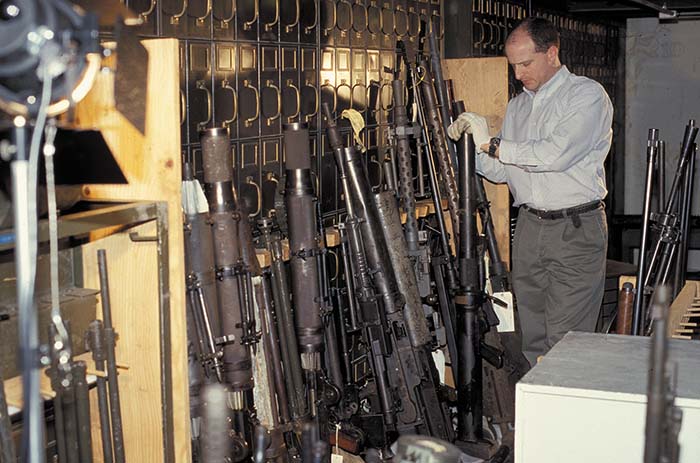
SAR: What do you expect to be getting in the near future?
Mark: We work closely with Naval Sea Systems Command, the Navy’s lead agency for small arms and are expecting examples of the M4 SOPMOD carbine as well as MK43 machine gun – a shortened M60. We will probably get in some precision rifles – sniper and marksmanship team weapons.
SAR: Why sniper type?
Mark: When we were in the vault you saw the .50 caliber rifle developed for Vietnam. That’s what I call a 1st generation. We have some of the 2nd generation rifles but we need to fill in gaps. Since the ones fielded in the ’80s and ’90s are reaching the end of their life cycle, this is an opportune time for some of them to come to NHC. Mainly these have served in the fleet – with UDT (Underwater Demolition Teams) and SEALs (Sea Air Land). But others will come from the Navy’s competitive marksmanship teams.
In getting these 2nd generation sniper weapons we will work with individuals still in the Navy and with records the Navy still holds to identify, at least down to team level and time in service, specific examples with interesting service histories.
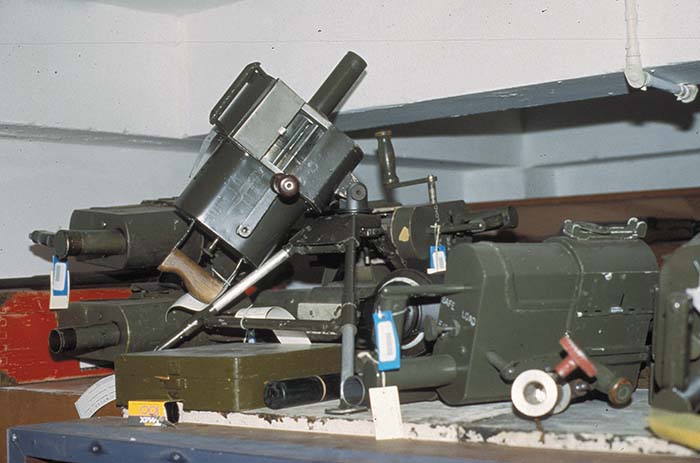
SAR: How do you spread the word so good pieces will come to the NHC collection?
Mark: We maintain contact with three main sources in the Navy and several others. In addition to the Navy Sea Systems Command, there is the Naval Surface Warfare Center at Crane, Indiana. Then, the “operational community” including SEALs, Special Boat Units, ships and the aviation community. We also ask the other Armed Forces to look out for Navy-marked weapons that they might have. The FBI and ATF are also on our contact list. Finally, we want the public to think about us for Navy-related items.
SAR: Is it appropriate for readers of SMALL ARMS REVIEW to donate Navy-related firearms, accessories and documentation?
Mark: Of course. Just pick up the phone and let us know or send a letter. We will provide a Deed of Gift that legally transfers the artifact to the NHC collection and a letter of appreciation. NHC itself very rarely buys anything except “high interest” items. That’s something the non-profit, private Naval Historical Foundation sometimes helps with.
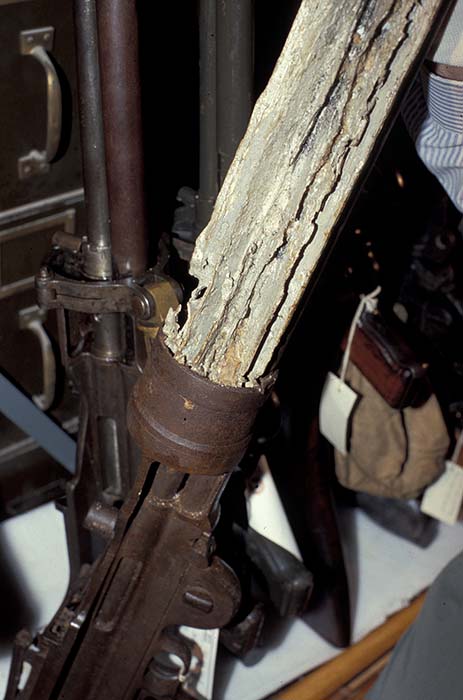
This rough looking Lewis Gun was recovered by Navy salvage divers from the final resting place of the USS Pope, a US warship sunk off Java in 1942. Interestingly, the steel receiver seems rather well preserved, but the aluminum fins of its air cooling radiator are badly corroded. Wooden grips and buttstock have long ago disintegrated. Credit: Robert Bruce
SAR: What weapons and/or accessories are particularly needed to fill in gaps in the collection?
Mark: Our biggest holes are in the 19th century to the cartridge era. Surprisingly, this gap is not in developmental weapons but the actual standard arms in service. Those prior to 1860 are few and far between because nobody held on to them at the time. Now, a high price has to be paid to acquire them so our chance to get that Colt revolving rifle from 1839 is not very good.
Another example is a 1795 Ship’s Service Musket, the first weapon acquired for America’s new Navy of the 1790’s and specifically for the USS Constitution during her construction.
SAR: How do you get most of your operational documentation?
Well, even in today’s operational community sometimes what is written technically doesn’t always reflect the actual use. So we have two ways of doing it. One is to go to the SEAL Teams and ask for their reports and other documentation showing what kinds of weapons and ammunition were carried on particular missions. Sometimes these reports are still classified even though the action took place many years ago, so the papers go into a restricted access collection we maintain.
The other way is to do oral history work and that is the responsibility of our Naval Reserve unit. They go out and do interviews with the technical and operational community such as when Navy Special Warfare units were deployed to the Persian Gulf for Desert Shield/Desert Storm.
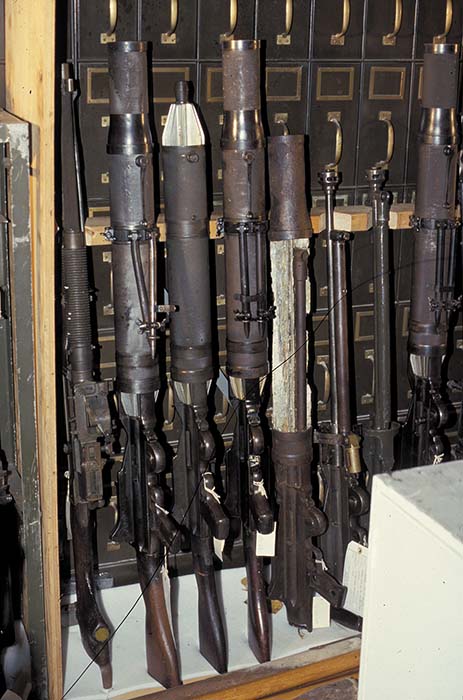
SAR: Any particular under-documented piece that could use more information from reasonably knowledgeable individuals?
Mark: We have the Navy’s first Gatling Gun from the group of 12 or 13 “test articles” as we would call them today, manufactured by Dr. Richard Jordan Gatling. One went to the Navy and was tested here at the Navy Yard circa 1862-63 and then got sent out West for operational testing. All we have on this is from secondary sources like books, and I would like to find some primary source material to tell the story.
It is said to be the only surviving example. The others were supposedly destroyed in an accidental fire at either the Colt or Gatling factory. Unfortunately, ours is missing its gravity feed mechanism. We have drawings and we know that the feed is similar to that on later guns but they aren’t interchangeable. Maybe some SAR reader will jump in with an original prototype Gatling gravity feed mechanism?
SAR: How can the general public get information or answers to questions about US Navy history in general and firearms in particular?
Mark: There’s a lot of information posted on our website, so that’s the best place to start. Then, if necessary, write us a letter. The Naval Historical Center answers some 30,000 letters each year.
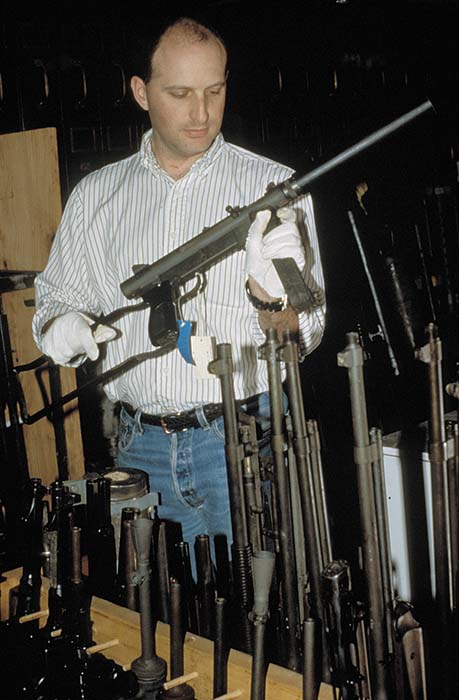
Curator Mark Wertheimer shows a suppressor-equipped Smith & Wesson M76 submachine gun used by Navy SEALs in Vietnam. This simple and effective 9mm sub was developed based on the Carl Gustav M45 “Swedish K.” Credit: Robert Bruce
SAR: Funding is tight and that affects the number of paid staffers at NHC. Do you use volunteers?
Mark: Yes, and we encourage more, (mostly for) general maintenance and help with the annual inventory required by the Navy. Someone who has experience in working with firearms and who wants to learn. If I have a volunteer on long enough and experienced enough, I will allow him to take the weapons apart if needed.
SAR: What particularly interesting opportunities have you had as a result of your position?
Mark: We have recently had the opportunity to fire the Thompson submachine gun.
SAR: Not the 1921/28 “overstamp”!? SAR readers would be falling on the floor!
Mark: (Smiling) No, of course not. It was a 1928A1 – we have a number of them in the collection — to familiarize some of the (NHC) staff with the capabilities and limitations of a submachine gun. (This was) done at the Anacostia (Maryland) Naval Station at an indoor range available for our use.
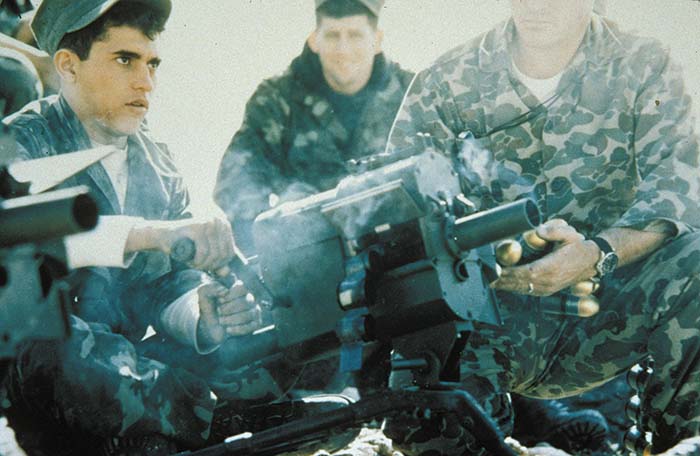
SAR: Tell us about some of the collectors, historians and writers who have benefited from the NHC’s resources.
Mark: Jerry Tarble is one of the few and far between Stoner collectors in the world. I’ve helped Kevin Dockery with his book SPECIAL WAR/SPECIAL WEAPONS, and Don Canney, specializing in Union Navy of the Civil War.
The weapons in our collection haven’t been seen much by the public, whether in books, magazines or video – never in video that I’m aware of. There are some museums that are quite popular for this type of work (books and magazines). The Smithsonian is one, the National Firearms Museum (NRA), and the Western Heritage Museum collection in Cody, Wyoming, is quite popular. Ours is one of the lesser-known treasures of our nation, of our Navy.
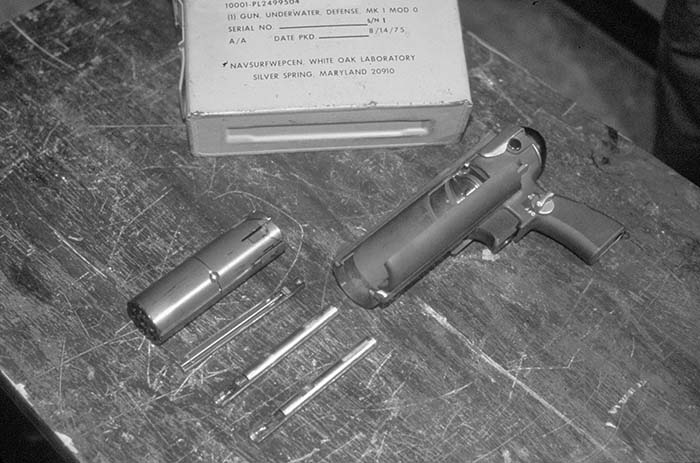
Find out More
The Naval Historical Center’s website is www.history.navy.mil
The “Virtual Museum Tour” on NHC’s website lists numerous firearms and edged weapons of historical note that are currently on display. Some examples include swords and firearms of the Revolutionary War, a re-creation of the USS Constitution’s Gun Deck, a Hotchkiss rifle from the Spanish American War, and weapons of the Navy and Marine Corps in World War I. The World War II gallery displays German firearms from D-Day, a twin 40mm AA Gun, and the very modestly-named “Little Boy” Atomic Bomb.)
Mailing address is:
Department of the Navy
Naval Historical Center
805 Kidder Breese SE
Washington Navy Yard
Washington, DC 20374-5060
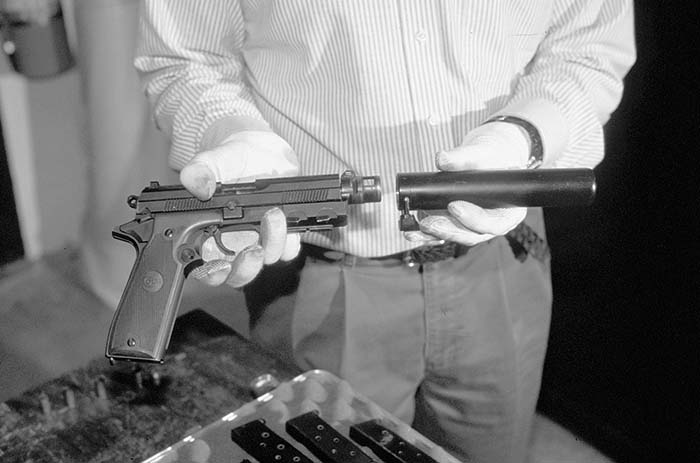
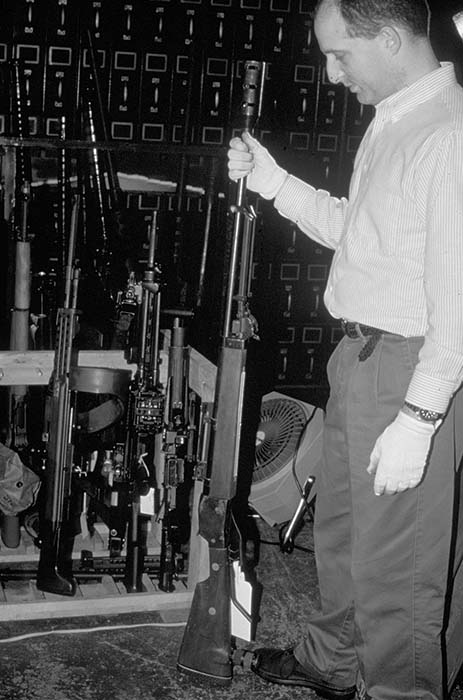
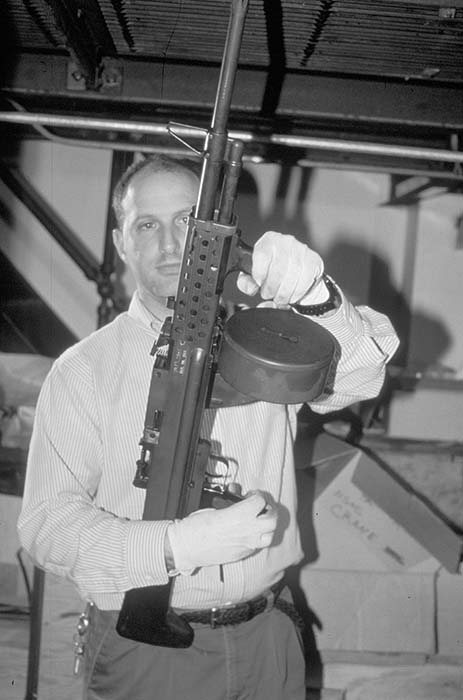
| This article first appeared in Small Arms Review V7N1 (October 2003) |











